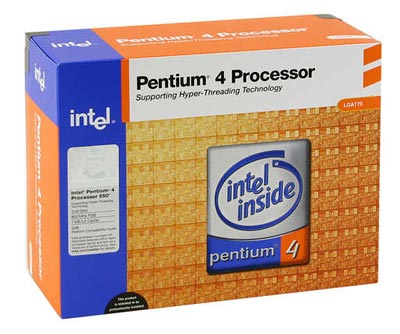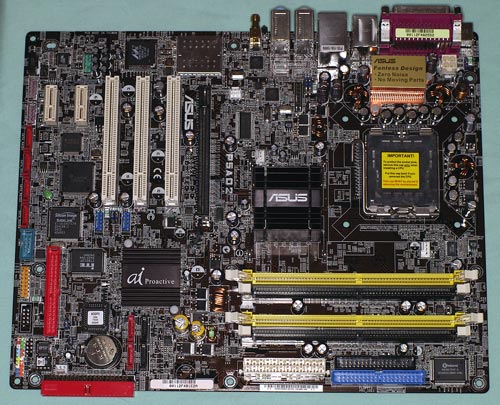High End Buyer's Guide - September 2004
by Wesley Fink on August 30, 2004 12:22 AM EST- Posted in
- Guides
CPU and Motherboard Alternatives
CPU: Intel Pentium 4 560 (3.6Ghz)Motherboard: Asus P5AD2 Premium (Intel 925X)
Price: CPU - $505 shipped (Retail with HSF). Motherboard - $264 shipped
It was difficult to decide between the Single-Channel Socket 754 Athlon 64 and the new Intel Socket 775 for the High-End alternative. Despite the massive increase in memory bandwidth that comes with the Dual-Channel 939, the fact remains that the Athlon 64 is not particularly bandwidth-starved compared to recent deep-pipe Intel designs. As you can see in the launch article on Socket 939, this translates into performance of the single-channel 754 Athlon 64 that is only 2% to 9% slower than the new 939 at the same speed. In real terms, this means that a Socket 754 combined with a second-generation Socket 754 motherboard with AGP/PCI locks is still slightly outperforming Intel's latest and greatest Pentium 4 560 (3.6GHz). The new pricing of the 2.4GHz 3700+ at about $525 also makes this tempting for the High-End Value shopper. The 754 is still a very good alternative, but in the end, the new Socket 775 on one of the motherboards that solves the Intel OC lock riddle won out as the High-End alternative due to the combination of features and future.

Intel produces processors with locked multipliers, so for raw performance, we chose the highest Intel stock speed. The Intel 560, running at 3.6GHz and based on the 90nm Prescott core, is the fastest Intel CPU you can buy today. As Anand found in the Socket 775 launch review CPU benchmarks, the 560 is generally faster than the more expensive 3.4EE, which has double the cache, but is based on the 130nm Northwood core. Most Socket 775 processors that we have tested tend to top out in the 3.8GHz to 4.0GHz range with modest voltage increases, so overclockers choosing a 775 CPU may want to choose a slower 775, like the 3.2GHz to balance ultimate overclock with board Clock frequency capabilities.
In this case, the Asus P5AD2 tops out at 278 with ATI PCIe video or about 260 with nVidia PCIe. We also showed, in our DDR2 memory roundup, that all current DDR2 memory could run at DDR2 667, which is achieved at a Clock frequency of 250. This means that if you are an experienced overclocker, you can achieve the same or higher performance with a 3.2E Socket 775 matched to the Asus P5AD2.
However, this is the High-End Buyer's Guide and there is no doubt that overall, the 560 is the fastest stock Intel Socket T processor that you can buy. This makes the 560 the ideal choice for a Socket T, PCI Express, DDR2 High-End system.

The Intel 925X chipset is Intel's Enthusiast chipset, and we recently compared 925X motherboards in our 925X Roundup. The Gold Editor's Choice in that roundup was the Asus P5AD2, which makes the Asus the logical choice for our High-End Intel system.
The P5AD2 Premium is clearly top-of-the-line in every way. All of the Asus Proactive AI (Artificial Intelligence) features are included, and Asus proudly advertises the overclocking features of the P5AD2 Premium. This includes a special cooling plate on the bottom of the board in the CPU area that Asus calls Stack Cool.
Asus includes Dual Gigabit PCI Express LAN on the P5AD2, with both LAN ports powered by the new Marvel 88E8053 Ethernet controllers. You will also find a complete WiFi set-up with an 802.11g card and antenna included for the WiFi slot. Asus uses the premium C-Media CMI9880 codec supporting the Intel High-Definition audio, with 8 channels and Dolby Digital Live technology support. The P5AD2 also adds the DDR2 memory option of 600MHz at stock speed in addition to the common 533 and 400 options.
The storage area is one area where the Asus stands out compared to other 925X boards. All 925X support the ICH6R standard 4 SATA/1 IDE (2drives) configuration. The Asus adds 4 more SATA ports for a total of 8 SATA ports, and also adds an ITE controller for 2 more IDE devices for a total of 4.
When Socket 775 was launched, it did not appear that any of the new 925X/915 motherboards would ever become a recommended performance motherboard. Performance was fine if you looked only at stock speeds, but the 925x/915 boards appeared limited to about a 10% overclock by design. This severely limited performance at the very top compared to Intel 875/865 chipset boards. However, the P5AD2 has turned out to be the best overclocker that we have seen so far among the 925X motherboards. In our tests, the Asus reached 278 FSB with the difficult combination of a top-end ATI X800 XT PCIe video card and a SATA hard drive. This puts the P5AD2 in the same performance ballpark as the best 875 boards, making it easier to choose a 925X system as the high end alternative system.
The P5AD2 is an expensive motherboard, but it will take 775 performance to places that are difficult to reach with other 925X motherboards. It was designed from the start to be a dream board for Performance computing, and Asus even provides a full range of AI overclock options for the more timid, with auto presets from 5% to 30% overclock, which represent a range of auto overclocks to FSB1066/DDR2-710.
There is also a full range of both familiar and new manual settings for overclockers who like to dial their own.
Listed below is part of our RealTime pricing engine, which lists the lowest prices available on the Intel CPUs and motherboards from many different reputable vendors:
If you cannot find the lowest prices on the products that we've recommended on this page, it's because we don't list some of them in our RealTime pricing engine. Until we do, we suggest that you do an independent search online at the various vendors' web sites. Just pick and choose where you want to buy your products by looking for a vendor located under the "Vendor" heading.










53 Comments
View All Comments
decptt - Sunday, September 12, 2004 - link
Sep 11, No OC guide again -_-"I am waiting for Fink' comment about HS/HSF.
rbils - Wednesday, September 8, 2004 - link
Ignore me. I read the comments last week, and didn't bother to read them again before I posted today. Sorry!rbils - Wednesday, September 8, 2004 - link
I didn't notice in the article, but are you using the included (retail) heatsink and fan that ships with the AMD processor? If so, do you feel that it is adequate as installed? I've read so much lately about 3rd party CPU coolers and thermal compound that it has me questioning whether or not the items shipping with the retail CPU are sufficient.Wesley Fink - Thursday, September 2, 2004 - link
The 480W True Power has been more than adequate for my tests, BUT the OCZ 520W was my recommendation for the last Overclocking Guide. I personally believe the Antec 480W is more than adequate, but the OCZ 520W does provide an extra margin of safety - particularly if you plan to overclock your video card or seriously overclock the whole system. The OCZ 520 has the added advantage of both 24-pin and 20 pin compatability as well. If you can handle the OCZ price of $150 it is an excellent choice.As for coolers, water cooling and phase-change are outstanding, but specialized and expensive, and beyond the scope of our recommendations. I have had good success with the stock A64 cooler made by Ajigo, and it is MUCH better than past AMD coolers - even for some modest overclocking. If you want more, there are coolers that do a better job. My favorites are the Scythe Samurai, the Thermalright SLK948U, and the Thermaltake Silent Boost K8. The Gigabyte 3D Cooler Ultra GT is also great-looking, but it really doesn't add that much in the way of improved cooling over the stock fan. The Samurai, SLK948U, and Gigabyte are Universal HSF and will work on most sockets.
southernpac - Thursday, September 2, 2004 - link
Congradulations on a comprehensive and well thought out guide. I will very shortly be relying on it a lot. Two concerns: As #16 has testified to his 480W PSU being inadequite, I would like for AnandTech to comment on this (we are relying on your advise in making this purchase). I realize that nVidia has revised their power requirement downward, but only after a lot of critism. As I don't want any more heat in the case than is really necessary, SHOULD more than 480W be shown necessary, I would also like your view of OCZ's 520W PSU.The one hole in the review certainly appears to be the lack of a recommendation for a better than "decent" (read adequite) cooler. If there are "better solutions" available - the high-end system should have it. Heat is the enemy of electronics, so the best cooler is worth while, particularly at only about $50. However it's not that simple - hence the need for a recommendation. #44 for example advocates his Zalman CNPS7000B-Cu, but if you look at Zalman's own site info on this cooler, Zalman specifically disavows moving any system having an installed cooler weigning over 450g. The 7000B-Cu weighs 755g (50% over Zalman's own limit). Many high-end coolers have similar weight. The just released Gigabyte 3D Rocket heat pipe cooler has just reduced it's weight to ONLY 500g's - but is it still effective now that it's aluminium instead of copper? Wesley please, we need a recommendation! In spite of the above - a great guide! Bill
NoGodForMe - Thursday, September 2, 2004 - link
Great article.I'd be interested in seeing if the Thermalright XP-120 fits in the Asus AV8 and other AMD boards for the FX53.
And most of these products are still hard to find. I'm sure someone will say they can get them, but it's very hard to do. For example, find me a BFG 6800 Ultra OC.
southernpac - Thursday, September 2, 2004 - link
gimper48 - Thursday, September 2, 2004 - link
When is the next Overclocking Review?!!swampy11 - Wednesday, September 1, 2004 - link
I certainly agree with your picks for the Hi-end set-up, but here is my question. With the new PCI-Express just around the corner and the supposed "horsepower" gain by this new architecture, should I jump in now with your suggested Hi-end recommendation or wait until the newer GPU and MB bear fruit.... probably fourth quarter?Thanks
`swamp
Uff - Wednesday, September 1, 2004 - link
Personally, I had quite a negative experience with my stock cooler, as soon as I locked the cam lever, it bent my motherboard just enough to make my RAM not make contact with the slots in the middle, resulting in failed boots. In addition to that, while it did keep my cpu temps at reasonable levels they were far from perfect.2 days later i received my Zalman 7000B-Cu and my temps dropped over 10C even if the cooler was running in silent mode (which is practically inaudible as opposed to the level of noise you get with the retail HSF).
While the stock cooler might do its job (barely), this was, after all, a high-end guide, and there's nothing high-end about that HSF.